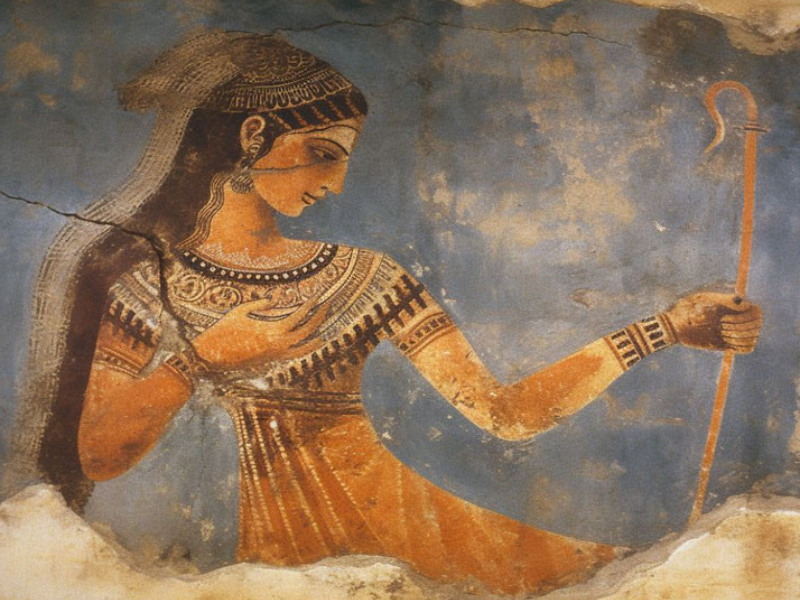Table of Contents
Introduction to the Minoan Religion
The ancient civilization of the Minoans, flourishing on the island of Crete, was deeply rooted in a rich and complex religious tradition. Central to their culture was a tapestry of beliefs and practices that encompassed a wide range of deities, rituals, and sacred spaces. This exploration into Minoan religion offers a glimpse into the spiritual life that was integral to one of the earliest civilizations in Europe.
Minoan Deities and Mythology
At the heart of Minoan religion were the deities they worshipped, most notably the Great Mother Goddess, a figure synonymous with fertility, life, and death, venerated in various forms across the Mediterranean.
Known also as Astarte, Ishtar, Cybele, Rhea, and Dictynna, she represented the cyclical nature of life. Alongside her stood Potidas, a god overseeing the earth, sky, and sea, embodying the natural phenomena from thunderstorms to earthquakes.
The mythology surrounding these deities was richly depicted in Minoan art, with symbols such as the snake, dove, and double axe, representing various aspects of their power and presence. These mythological narratives were not mere stories but were integral to understanding the Minoans’ perception of the world around them.

Sacred Ceremonies and Rituals
Minoan religious life was marked by a variety of rituals and ceremonies, ranging from the celebratory to the somber. One of the darker aspects of their practices was human sacrifice, believed to be performed during times of crisis or as part of specific religious ceremonies, as evidenced by findings at sites like Anemospilia.
In contrast, the Minoans also engaged in vibrant communal dances, possibly as part of fertility rites or religious festivals, reflecting the community’s social and religious cohesion.
Taurokathapsia: The Bull-Leaping Ritual
Among the most iconic and enigmatic of Minoan rituals was Taurokathapsia, the bull-leaping ceremony. This practice involved athletes performing acrobatic feats over a bull, a spectacle depicted in various frescoes, most famously in Knossos.
Unlike the later bullfighting traditions, Taurokathapsia was more of an athletic display than a fight, symbolizing perhaps a harmony between humans and nature or a rite of passage.
Sacred Spaces: Palaces, Peaks, and Caves
In Minoan Crete, the sacred was not confined to temples alone; it permeated various spaces, each with its own spiritual significance. The palaces, such as the grand Palace of Knossos, served as religious centers, housing ceremonial spaces adorned with sacred symbols. These palatial structures, with their intricate architectural designs, were more than royal residences; they were the epicenters of Minoan religious life.
The Minoans also revered natural landscapes as sacred. Peak sanctuaries, set atop mountains, provided serene settings for worship, connecting the Minoans with the divine realms above. Sites like Mount Juktas and Petsofas were integral to their religious landscape, offering panoramic vistas that merged the earthly with the heavenly.
Similarly, sacred caves, such as the one at Psychro, were considered portals to the underworld or sanctuaries of deities. These natural formations, with their mysterious and awe-inspiring interiors, played host to various rituals, from offerings to initiation ceremonies, reflecting the Minoans’ reverence for the natural world.
The Legacy of Minoan Religion
The religious practices of the Minoans left a lasting legacy on the island of Crete and beyond. Their influence can be seen in the subsequent Greek and Roman cultures, with certain deities and rituals finding echoes in later mythologies.
The archaeological discoveries from Minoan sites continue to provide invaluable insights into their spiritual world, offering a window into the religious life of one of the earliest European civilizations.
Conclusion
The tapestry of Minoan religion, woven with diverse deities, complex rituals, and sacred spaces, offers a rich and multifaceted view of this ancient civilization. From the communal dances to the solemn rites, and from the grandeur of their palaces to the serenity of their peak sanctuaries, the spiritual life of the Minoans was a vibrant and integral part of their culture.
Understanding Minoan religion not only sheds light on their own society but also helps us understand the broader narrative of religious development in the ancient world.


